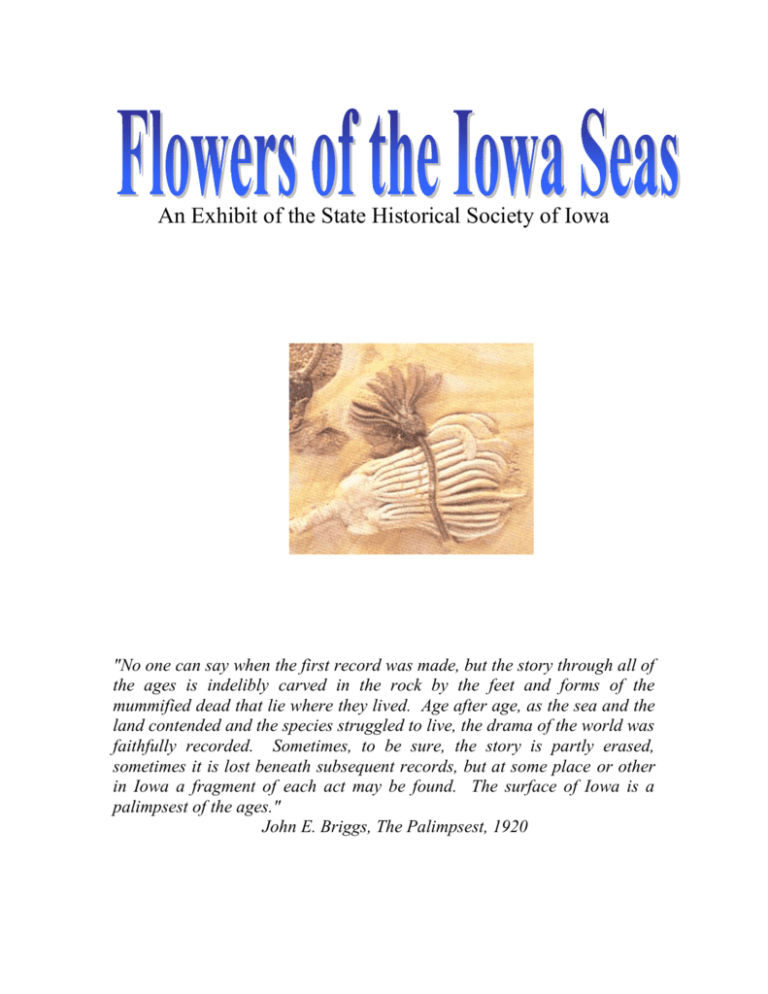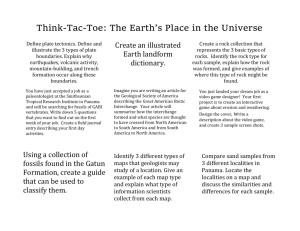tertiary - State Historical Society of Iowa
advertisement

An Exhibit of the State Historical Society of Iowa "No one can say when the first record was made, but the story through all of the ages is indelibly carved in the rock by the feet and forms of the mummified dead that lie where they lived. Age after age, as the sea and the land contended and the species struggled to live, the drama of the world was faithfully recorded. Sometimes, to be sure, the story is partly erased, sometimes it is lost beneath subsequent records, but at some place or other in Iowa a fragment of each act may be found. The surface of Iowa is a palimpsest of the ages." John E. Briggs, The Palimpsest, 1920 EVIDENCE FROM THE PAST Rocks and fossils provide evidence of earlier lives and environments. Interpreting the specimens allows a geologic and zoological history of an area to be written. You may be discover interesting Rocks and fossils as walk the stream valleys and rock outcrops of Iowa. A concrete sidewalk is a humanmade layer of rock. It is composed of rock fragments and binding material shaped by confining borders. Simple tools mix sand, water, and portland cement together to form a rock-like sidewalk. A wooden form holds the mixture in place until it hardens.Like a fossil in a rock, a leaf or footprint in wet cement remains after the cement hardens. * Rocks are products of environmental processes in the world around us. Observing an eruption of Mount St. Helen, a flood on the Mississippi River, or the movement of beach sands in the Bahamas allows us to understand how rocks containing similar features are formed. This is known as the principle of uniformitarianism. Limestone is formed from the compacted shells of marine organisms or precipitates like dust as the water evaporates. Its presence indicates and area once covered by seas. Sand and gravel collect along seaside beaches and stream valleys to be cemented by waterborne material. These sandstones may preserve evidence of currents, wave actions, and the footsteps of ancient animals. Coal forms when large quantities of plant material compress and decay without oxygen, a condition common to swamps and marshes. Shale forms when muddy bottoms of quiet lagoons, swamps or rivers dry out, compress, and harden through time Layers of gypsum form when calcium and sulfur concentration increase as sea water evaporates Cement forms when limestone and clay are burned together and then ground into dust. Iowa is a leading producer of portland cement. Geologic Time We usually think of time in years, generations and civilizations. Yet geologic time extends over billions of years. It identifies the age o rock groups and which unit of rock is older than another. Older rock are normally found below younger ones. The geologic time scale places rocks and fossils into sequence. The order is established by which rock unit is older than another and confirmed by index fossils and radioactive dating. Iowa rocks do not show a continuous rock record, vast periods of time and geologic deposits are missing. Their absence indicate periods of erosion or an environment that did not produce rock deposits. CENOZOIC QUATERNARY RECENT PLEISTOCENE The last 3 million years (the Pleistocene period) is represented across Iowa by glacial deposits. Erosion characterized Iowa during the remainder of the Cenozoic period. TERTIARY PLIOCENE MIOCENE OLIGOCENE EOCENE PALEOCENE MESOZOIC CRETACEOUS JURASSIC TRIASSIC PALEOZOIC PERMIAN CARBONIFEROUS PENNSYLVANIAN DEVONIAN SLURIAN ORDOVICIAN CAMBRIAN PRECAMBRIAN The time from 65 to 230 million years ago. Only portions of the Cretaceous and Jurassic periods are represented in Iowa. These deposits are stream and coastal sediments mixed with marine sediments of limestone, shale, and gypsum. The sediments were formed 230 to 600 million years ago. Repeated episodes of marine, stream, and coastal environments produced limestone, sandstone, coal, and shale as characteristic deposits. The oldest rock on earth from 600 million to 4.5 billion years old. A long and complex time of deposition, mountain building, and erosion. Rocks of this age are visible in Northwest Iowa. Geologic Map of Iowa* Iowa's bedrock is exposed at the surface in the ribbons of ages that cross the state. Each color represents deposits of a different age. At Burlington, Le Grand, Sioux City, and across the state, we can see exposed layers rock--limestone, sandstone, dolomite, siltstone and shale. These layers are not the same age or thickness in all parts of Iowa. Because of uneven deposits and erosion they thicken and thin, disappear and blend across the state. The map colors represent rock ages and their distribution as exposed rock beneath the glacial till. The display of the colors is effected by the angle the rock lies within the earth, structure, and the extent of erosion of the surface exposure. Stream valleys cut through younger rock and expose older as the upper layers are eroded away. Erosion may leave remnants of younger or older rock as “islands” in areas of another age. The geologic map provides a quick way to determine what rocks are exposed near the surface, although they may be covered by glacial deposits, in any area of Iowa. *The Iowa Geological Survey Bureau, Department of Natural Recourses, provides copies of the Iowa geological map and physiological region map on their website: http://www.igsb.uiowa.edu/browse/geoiowa/geoiowa.htm.








